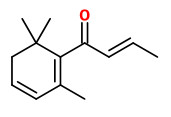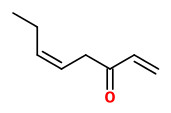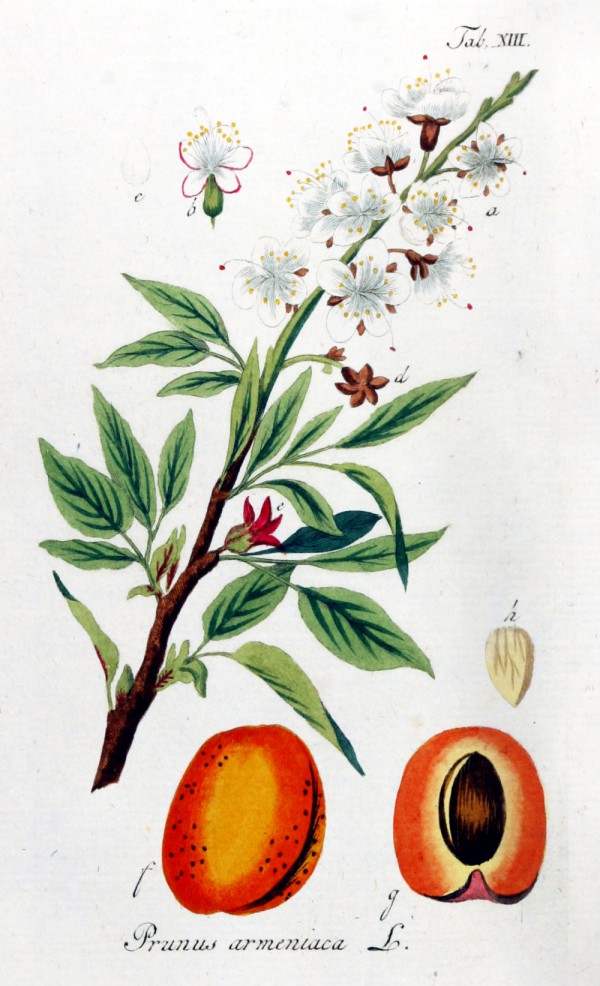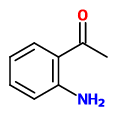Prunus armeniaca L. - Rosaceae - apricot, Armenian plum, Aprikose, Marille
Deciduous tree, up to 6m tall; leaves heart-shaped, toothed on the margin; flowers solitary, pinkish white, fruit fleshy, yellow to orange, stone smooth, sharp-edged.
„The origin of the species is disputed. It was known in Armenia during ancient times, and has been cultivated there for so long, it is often thought to have originated there.“ http://en.wikipedia.org/wiki/Prunus_armeniaca
flower
„The combination of 2-aminobenzaldehyde and 2-aminoacetophenone, sometimes accompanied by methyl anthranilate, can be regarded as a scent concept important to nature and frequently found in nature, e.g. In Prunus species.“ The headspace of Prunus armeniaca flower contained 2-aminobenzaldehyde (1.1%; orange-flower like) and 2-aminoacetophenone (0.8%; grape, sweet green; high impact - odor threshold in the picogram range).
[R.Kaiser, Scent of the Vanishing Flora, Zurich 2011, 21, 34]
fruit
„The esters were clearly the dominant constituents in the headspace sample. The major esters identified were
butyl butanoate (29.66%), butyl hexanoate (24.54%), hexyl butanoate (11.78%), ethyl hexanoate (4.70%), hexyl hexanoate (4.12% ), hexyl 2-methylbutanoate (3.50%), butyl 2-methylbutanoate (2.76%), ethyl butanoate (2.00%), pentyl butanoate (1,8%) , and butyl propanoate (1.30%)…
Based on their odor threshold and their amount present in the headspace, the following compounds probably contribute to the intact apricot odor: ethyl butanoate, ethyl 2-methylbutanoate, butyl butanoate, ethyl hexanoate, butyl 2-methylbutanoate, hexyl 2-methylbutanoate, and γ-decalactone.“
[Volatile constituents of apricot (Prunus armeniaca). Takeoka, G. R., Flath, R. A., Mon, T. R., Teranishi, R., Guentert, M., Journal of Agricultural and Food Chemistry, Vol.38(2), 1990, 471-477]
„A correspondence analysis showed that cultivars could be separated into three clusters, according to their typical aroma. Hexyl acetate, γ-octalactone and γ-decalactone were shown to be key compounds for the apricot flavor whereas benzaldehyde could have a negative impact on the aroma of the less aromatic cultivars but would favorably complete the typical aroma of Rouge du Roussillon.“
[Composition of apricot aroma: correlations between sensory and instrumental data. Guichard, E., Schlich, P., & Issanchou, S., Journal of Food Science, Vol.55(3), 1990, 735-738]
The lactones of apricot like γ-hexalactone (10-245 ppb), γ-decalactone (300-610 ppb), γ-dodecalactone (40-75 ppb), δ-decalactone (85-115 ppb), are preferentially (R)-configured (80-98% ee) with the exception of (Z)-7-decen-5-olide (jasminlactone; 50-160 ppb; S 94-95%ee).
[Engel, K. H., W. Albrecht, and R. Tressl. „Chirality and aroma compounds: Bioformation and evaluation.“ Aroma perception formation evaluation. Proceedings of the 4th Wartburg Aroma Symposium. 1994, 230-246]
„The aroma volatiles of the apricot distillate were characterized by a high concentration of alcohols and by a specific terpene profile that included linalool, ocimenol, α-terpineol, nerol, geraniol, cis and trans linalol oxide. γ-Decalactone, γ-dodecalactone, and ethyl cinnamate were also characteristic of the apricot distillate. The apple distillate exhibited a high concentration of esters and was characterized by the presence of farnesol, cis and trans α-farnesene, ethyl hexanoate, ethyl 9-decenoate, ethyl 3-methylbutanoate, guaiacol and (Z) 3-hexen-1-ol. In the case of apricot distillate, olfactometric analysis showed that volatile compounds, such as β-damascenone, ethyl 2-methylbutanoate, linalool, methyl anthranilate, ethyl cinnamate, γ-decalactone and γ-dodecalactone, which probably resulted from the original fruit, had a significant odor activity, while 2-phenylethanol was the main odor impact compound. The aroma profile of the apple distillate was mainly characterized by 2-phenylethanol, β-damascenone and ethyl 3- and ethyl 2-methylbutanoate.“
[Genovese, Alessandro, et al. „Comparison of the aroma compounds in apricot (Prunus armeniaca, L. cv. Pellecchiella) and apple (Malus pumila, L. cv. Annurca) raw distillates.“ Italian Journal of Food Science/Rivista Italiana di Scienza degli Alimenti 16.2 (2004)]
„Finally, 10 compounds, ethyl acetate, hexyl acetate, limonene, β-cyclocitral, γ-decalactone, 6-methyl-5-hepten-2-one, linalool, β-ionone, menthone and (E)-hexen-2-al were recognized by HS-SPME-GC-O as responsible of the aromatic notes involved in apricot aroma and considered as molecular tracers of apricot aromatic quality which could be utilized to discriminate apricot varieties.“
[Aroma characterization of various apricot varieties using headspace-solid phase microextraction combined with gas chromatography-mass spectrometry and gas chromatography-olfactometry. Guillot, S., Peytavi, L., Bureau, S., Boulanger, R., Lepoutre, J. P., Crouzet, J., & Schorr-Galindo, S., Food Chemistry, Vol.96(1), 2006, 147-155]
 γ-decalactone (peach coconut) |  (E)-β-damascenone (apple rose) |  (Z)-1,5-octadien-3-one (green marine) |  (E,Z)-2,6-nonadienal (green cucumber) |
„An aroma extract dilution analysis applied on an aroma distillate prepared from fresh apricots revealed (R)-γ-decalactone, (E)-β-damascenone, δ-decalactone, and (R/S)-linalool with the highest flavor dilution (FD) factors among the 26 odor-active compounds identified. On the basis of quantitative measurements performed by application of stable isotope dilution assays, followed by a calculation of odor activity values (OAVs), β-ionone, (Z)-1,5-octadien-3-one, γ-decalactone, (E,Z)-2,6-nonadienal, linalool, and acetaldehyde appeared with OAVs >100, whereas in particular certain lactones, often associated with an apricot aroma note, such as γ-undecalactone, γ-nonalactone, and δ-decalactone, showed very low OAVs (<5). An aroma recombinate prepared by mixing the 18 most important odorants in concentrations as they occurred in the fresh fruits showed an overall aroma very similar to that of apricots. Omission experiments indicated that previously unknown constituents of apricots, such as (E,Z)-2,6-nonadienal or (Z)-1,5-octadien-3-one, are key contributors to the apricot aroma.“
[Characterization of the key aroma compounds in apricots (Prunus armeniaca) by application of the molecular sensory science concept. Greger, V., Schieberle, P., Journal of agricultural and food chemistry, Vol.55(13), 2007, 5221-5228]
Major volatile components of dried (sun, hot air, microwaves) aricots were 5-hydroxymethylfurfural (5-HMF), 2,3-dihydro-4-H-pyran-4-one and furfural. When apricots were dried using only a desiccator, limonene (16.3%), (E)-2-hexenal (9.3%), γ-decalactone (7.8%), butyl acetate (6.9%), β-ionone (5.9%), acetic acid (4.8%) and isobutanal were found to be the major components.
[Göğüş, Fahrettin, Mustafa Z. Özel, and Alastair C. Lewis. „The effect of various drying techniques on apricot volatiles analysed using direct thermal desorption-GC-TOF/MS.“ Talanta 73.2 (2007): 321-325]
(R)-(+)-γ-decalactone was the predominant enantiomer (94-100%) in the headspace aroma of 14 apricot fruit cultivars, but (R)-(+)-γ-dodecalactone (although enantiomerically pure) was detected in only five cultivars. γ-Nonalactone and γ-undecalactone were absent. Enantiomeric composition of γ-decalactone and γ-dodecalactone did not change during ripening.
[Ravid, Uzi, et al. „Authenticity assessment of natural fruit flavour compounds in foods and beverages by auto‐HS-SPME stereoselective GC-MS.“ Flavour and fragrance journal 25.1 (2010): 20-27]

Zorn, J., Oskamp, D.L., Vervolg op de Afbeeldingen der artseny-gewassen met derzelver Nederduitsche en Latynsche beschryvingen, vol. 1: t. 13 (1813)
http://plantgenera.org/species.php?id_species=1265091
Prunus armeniaca
© Rolf Marschner (2006),
www.botanische-spaziergaenge.at

